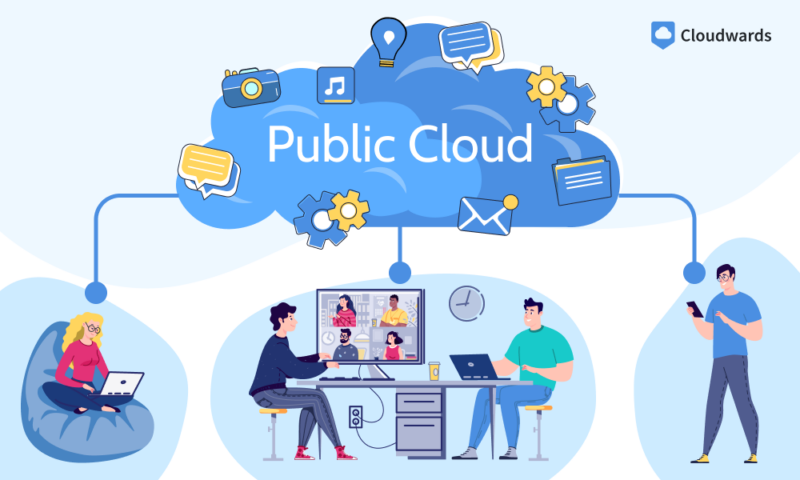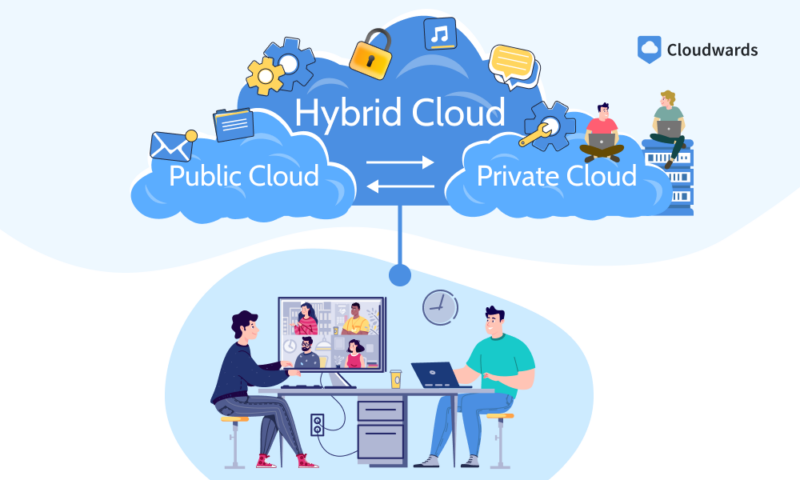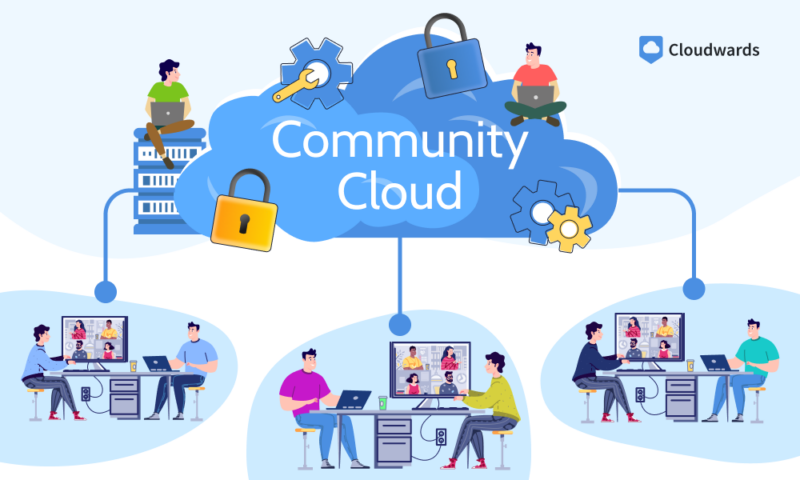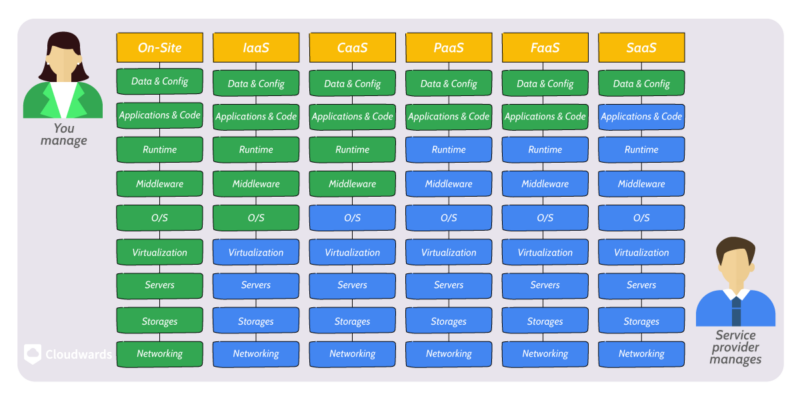Cloud Deployment Models: Definition & Types
It's possible to define a cloud environment based on a few different criteria, but one of the most common ways is by looking at which of the five cloud deployment models it uses.
All cloud computing solutions can be classified based on what deployment model they use. A deployment model refers to how the cloud solution is delivered to and accessed by the end user. In an effort to standardize terminology in the cloud computing market, the National Institute of Standards and Technology (NIST) published a landmark paper in 2011 that defined four core cloud deployment models.
The types of cloud deployment models defined by NIST include public, private, hybrid and community deployment. Additionally, in the years since the original NIST paper came out, a fifth deployment model — multi-cloud deployment — has also emerged.
When choosing a cloud deployment model, you must consider your organization’s needs and how the different deployment models can help with your use case. If streamlining and cost are the primary concerns, a public cloud is ideal. On the other hand, if your organization needs a custom solution, or if it frequently handles regulatory or sensitive data, a private cloud might be preferable.
-
11/19/2024
Updated article with important key takeaways.
What Is a Cloud Deployment Model?
A cloud deployment model describes how a cloud computing solution is delivered to the end user, and how that end user can access the resources and tools provided. More specifically, it tells you which entity owns the actual cloud infrastructure, what scale the solution operates on and what kind of access the end user has to each component.
What Are the 5 Types of Cloud Deployment Models?
The types of cloud deployment models include public, private, hybrid, community and multi-cloud computing. As mentioned earlier, cloud computing solutions are categorized by one of five different cloud deployment models — four that are defined by NIST and one that has developed independently.

are public, private, hybrid and community.
1. Public Cloud
Public clouds are the most common type of cloud computing model. These clouds are owned by third-party dedicated cloud providers that rent out access to the software and underlying infrastructure on a pay-as-you-go basis. These clouds can operate as different types of cloud computing, such as IaaS, PaaS or SaaS.
Examples of popular public cloud providers include IaaS and PaaS providers like Amazon Web Services (AWS) and Microsoft Azure, as well as consumer-facing SaaS products like Dropbox, Gmail and Slack.

Public clouds are usually powered by vast, centralized server farms that pool all of their resources together. These clouds either dynamically allocate the resources that each client requires based on previously agreed upon provisions, or they do so automatically based on current traffic and demand.
Because of this system, public clouds offer essentially infinite scaling potential from the end user’s perspective, as the actual hardware and underlying infrastructure are abstracted out of their view.
Public Cloud Benefits & Challenges
Setting up and maintaining a public cloud solution is generally simpler and less involved than other deployment models, simply because users have relatively few aspects to manage on their own. It’s also usually much easier to find solutions to problems as there’s a large pool of trained experts and troubleshooting documentation available online.
When you also consider the fact that you only pay for the resources you need at any given moment, public clouds become very cost-effective. Instead of acquiring and maintaining hardware (whether you own it or rent cloud hardware with dedicated access), you simply provision more resources as needed and relinquish them when they’re no longer being used.
A common concern with public clouds is security. Common sense dictates that something public is less secure than something private, but it’s not necessarily that simple. It’s true that public cloud data breaches are often disastrous, since individual clients aren’t able to react quickly enough because they must wait for customer support.
However, public clouds also have far more resources to spend on security and patching than most individual organizations, particularly those with a private cloud environment. This is especially relevant when it comes to updates, as cybercriminals are constantly looking for new gaps in security to exploit.
The biggest problem with using an entirely public cloud deployment model is meeting regulatory compliance requirements in areas like data retention and handling. For example, a public cloud provider might not be able to guarantee that a piece of data is completely deleted or be able to ensure strict enough access controls for confidential files.
Public clouds are the best choice for most organizations that are thinking about switching to cloud computing, unless you need niche, custom-built solutions or handle data that can’t be transferred to a public server due to regulatory requirements. In such cases, a hybrid approach will probably be the way to go.

2. Private Cloud
Private clouds are the opposite of public clouds, and they are as close as a cloud solution can get to traditional on-premises architecture. With a private cloud deployment model, the client either owns the hardware that operates the cloud (known as an internal cloud), or rents exclusive access to it (sometimes referred to as a virtual private cloud).
In either case, the client’s direct access to the underlying infrastructure can be much higher, since it’s not being used to power other cloud solutions as well.
Private Cloud Benefits & Challenges
How difficult it is to set up and maintain a private cloud depends on how much customization and specialization is required to meet the client’s needs. Third-party private cloud services like IBM Cloud or Cisco offer a relatively streamlined approach, whereas self-hosting on your own hardware significantly raises the complexity and costs of both setup and maintenance.
However, one potential benefit of private clouds is that they can take advantage of your current infrastructure, turning existing on-premises hardware into private cloud resources.
That said, a private cloud will always be significantly more expensive than a public one. It requires an in-house (or third-party) IT team to manage maintenance and potentially the hardware itself, as well as a dedicated support staff to handle security and emergencies.
Consequently, this leads to fixed scalability as the client must invest a significant amount of resources to expand the capacity of the cloud, either by renting even more dedicated infrastructure, purchasing more hardware or potentially training new people.
A private cloud can be more secure than a public one in the sense that it’s more obscure, meaning fewer people even know it exists in the first place. Even so, maintaining security and handling data breaches on a private cloud is difficult, costly and time-consuming, further compounding the problems of cost and scalability.
A fully private cloud model is really only feasible for very large corporations that have the resources required to maintain the system and keep it secure. While smaller organizations might still benefit from private clouds, they’re better served by going with a hybrid cloud approach instead.

3. Hybrid Cloud
The hybrid cloud deployment model offers a middle ground between public and private clouds. Instead of diving into a public cloud provider, clients can keep some data, workflows or processes on a smaller private cloud. This private part can then be tailored for its relatively narrow use case while still allowing users to benefit from the public cloud model for the rest of their operations.
Not all data and processes share the same needs when it comes to security or regulatory compliance, so hybrid cloud computing is incredibly common. Most large public cloud providers like AWS, Google Cloud and Microsoft Azure offer hybrid cloud functionality that makes it relatively simple to set up.
The hybrid cloud deployment model not only allows you to separate out sensitive data and comply with regulations, but it’s also a good way to stagger a cloud migration into multiple stages. This way, an organization can “dip its toes,” so to speak, without moving all of its operations over to the cloud at the same time.

4. Community Cloud
Of the four cloud computing deployment models defined by NIST, the community cloud model is by far the least common. The community cloud deployment model is similar to the private one, except it serves a set number of organizations rather than just one.
This is beneficial for users who have similar needs and use cases, but lack the individual resources to develop and maintain a customized cloud solution. However, implementing it requires a large degree of cooperation and trust between organizations, which is why it’s most commonly used by government agencies and nonprofits.
Aside from having the ability to pool resources and costs between several organizations, there’s little that separates a community cloud from a private one in terms of function. Ownership of the infrastructure and cloud solution would either be jointly held by the participating organizations, or owned by the cloud provider but rented out on an exclusive basis to those clients.
Because of its low adoption rate, community clouds are still largely theoretical, but they provide an interesting avenue for the future of cloud computing as cloud adoption becomes universal and cloud spending increases.

5. Multi-Cloud
Pros
- Can take advantage of unique features on several platforms
- Reduces the chances of vendor lock-in
- Great for software development and testing on multiple environments
Cons
- Usually more expensive than a single cloud
- Requires some sort of middleware or management application
- Complicates workflows by adding more components
The multi-cloud model is the only one that isn’t defined by NIST, and that’s because it’s essentially just multiple public or private clouds stitched together by some kind of middleware.
As the cloud computing field has matured and standardized, the large public cloud services have become easier to integrate with each other. This allows an organization to take advantage of tools and solutions from multiple providers and avoid vendor lock-in.
Although cloud providers usually have some level of multi-cloud capability built in, there are also solutions that are dedicated entirely to acting as a middleware or mediator between two or more cloud services — as explained in our single cloud vs multi cloud article.
The downside of relying on a multi-cloud deployment model is that you’re suddenly paying to maintain access to multiple systems, which can quickly make costs balloon. It also creates more complex workflows, as system administrators must be trained on many different products.
A multi-cloud model is usually the most useful to companies that need specific features only offered by certain cloud providers. It’s also beneficial for software development companies that might need to test their products on multiple different environments. For most other use cases, the multi-cloud deployment model is probably too costly and complex to be worth it.
What Factors to Consider When Choosing a Deployment Model?
To choose a cloud deployment model, consider your use-case and the compliance, ownership, access, traffic size, initial setup, maintenance, cost, scalability, reliability and security of each model:
- Use case: The absolute first thing to consider is the precise use case of your cloud system. This involves contemplating what kind of data and processes you want to host on the cloud, and which people — either inside or outside your organization — need to use it.
- Compliance: If your business or organization is subject to any kind of regulatory requirements, it’s important to think about how the different cloud models affect your ability to comply.
- Ownership: Are you required to retain physical ownership over any parts of your systems? This is often due to regulatory needs or highly confidential data.
- Access: Who needs access to your cloud system? Is it purely an internal tool for use within the organization, or is it intended for external users as well?
- Size: What kind of traffic or load do you anticipate the system to experience? This will affect the required size and redundancy of the system.
- Initial setup: What kind of resources — in terms of money, time and manpower — does your organization need to dedicate to initial setup?
- Maintenance: What capacity does your organization have to conduct running maintenance of your system? Can you contract a dedicated support team or hire in-house security and disaster recovery specialists, or do you need to rely on a cloud provider’s security competence?
- Cost: How expensive can your cloud solution be?
- Scalability: What level of scalability must your cloud solution have as your operations grow or shrink? Do you anticipate the load to be relatively static, or will it fluctuate during different times of the day, month or year?
- Reliability: What kind of uptime do you need out of your cloud solution? If the system is ever down for a period of time, what consequences will it have for business continuity?
- Security: Similar to maintenance, is your organization capable of maintaining its own data security by hiring or contracting specialists? If not, a public or hybrid cloud approach is probably more secure.
Comparison of Different Cloud Deployment Models
Here’s a quick comparison of different cloud models, including public cloud, private cloud, hybrid cloud, community cloud and multi-cloud computing. It’s based on factors such as ownership, access type, size of cloud, setup and maintenance complexity, cost efficiency, scalability, reliability and security.
| Factors: | Public Cloud | Private Cloud | Hybrid Cloud | Community Cloud | Multi-Cloud |
|---|---|---|---|---|---|
| Ownership | Cloud provider | Client or cloud provider | Cloud provider & potentially client | Cloud provider or jointly held by a group of clients | Multiple cloud providers |
| Access Type | No direct access to infrastructure or hardware | Direct access to underlying cloud resources | Partial direct access to infrastructure | Direct access to underlying cloud resources | No direct access to infrastructure or hardware |
| Size of Cloud | All companies or organizations that sign up with the cloud provider | One company or organization | Public portion shared with other clients, private portion limited to one company or organization | Set number of companies or organizations | All companies or organizations that sign up with the cloud providers |
| Setup Complexity | Easy | Complex | Moderate | Very complex | Moderate |
| Maintenance | Easy | Complex | Moderate | Complex | Moderate |
| Cost Efficiency | High | Low | Moderate | Moderate | Moderate |
| Scalability | High | Low | High | Low | High |
| Reliability | Low | High | Moderate | High | Low |
| Security | Generally high, but data breaches can be disastrous | Very high, but expensive to maintain | High | Very high, but expensive to maintain | Lower due to introducing more potential fault points |
| Best Fit | Most companies | Large corporations & multinational enterprises | Companies with sensitive datasets or regulatory obligations, or those needing to gradually transition to the public cloud | Government agencies & nonprofit organizations with similar goals and use cases | Software companies & other organizations with very specific platform requirements |
Which Cloud Deployment Model Is the Most Economical?
In the vast majority of cases, the most economical cloud deployment model is public cloud computing, or hybrid cloud computing that mostly relies on the public cloud.
How to Deploy an Application on the Cloud?
To deploy an application on the cloud, you first have to make several choices based on the application’s target audience and its intended function. First, you need to choose a cloud deployment model, which will probably be public or hybrid cloud computing in most cases.
Next, you must choose the service model — namely, whether you want to use an IaaS, PaaS or SaaS model for your application.
How to Choose a Cloud Service Model for Your Application?
To choose a cloud service model for your application, you need to consider what your application is meant to do and who is going to use it. For example, if you’re looking for a CRM solution for your company, chances are going with an already established SaaS product will save a lot of time and money, as you likely won’t need to customize anything.

and what the client or end user will manage.
On the other hand, if you want to create something more precise — for example, an application that interacts with a specific and unique part of your business operations — then you’ll need to build it yourself.
At this point, you can choose between IaaS and PaaS (or potentially CaaS and FaaS solutions for simpler applications). If you need complete control over every part of the application’s stack, then renting the raw infrastructure from an IaaS provider is the way to go. While PaaS takes some of that control and reduces your flexibility, scaling and maintenance become much easier to handle.
What Are Some Cloud Service Providers to Deploy an Application?
The most popular cloud service providers for deploying an application are AWS, Microsoft Azure and Google Cloud, otherwise known as the “big three” of cloud computing.
For most users, the easiest way to deploy a cloud application is by using a PaaS solution to handle things like automatic scaling and update deployment. If you want more control and flexibility regarding the underlying infrastructure and application design, you might prefer using a raw IaaS solution.
Final Thoughts
With that, we’ve reached the end of our cloud deployment model rundown. In summary, public clouds provide scalability, cost-effectiveness and better security than you might think. If one cloud provider lacks certain functionalities, then it’s also possible to connect multiple clouds together.
That said, hybrid clouds offer a smooth transition and have the ability to keep mission-critical applications or sensitive data on-premises, while private clouds offer a degree of flexibility and control for organizations with the resources to handle it.
What did you think of our guide? Do you have a better understanding of what factors to consider when deciding on a deployment model? Let us know in the comments below. Thank you for reading.
FAQ: Cloud Computing Deployment Models
Cloud deployment refers to how a cloud solution is hosted, owned and delivered to its users.
The four cloud deployment models defined by NIST are public, private, hybrid and community.
The three basic cloud service models are Infrastructure as a Service (IaaS), Platform as a Service (PaaS) and Software as a Service (SaaS).
The right cloud deployment model for your application or system depends on a number of factors, but in most cases, the best cloud deployment model will be a public or hybrid one.

